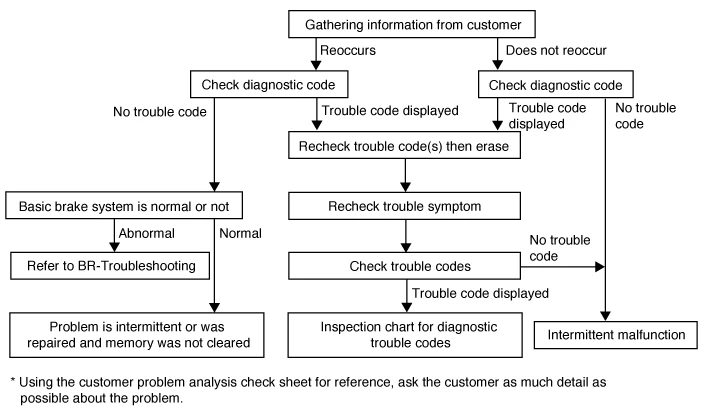Troubleshooting
Failure Diagnosis
1.In principle, ESC and TCS controls are prohibited in case of ABS failure.
2.When ESC or TCS fails, only the failed system control is prohibited.
3.The solenoid valve relay should be turned off in case of ESC failure, refer to the ABS fail-safe.
4.Information on ABS fail-safe is identical to the fail-safe in systems where ESC is not installed.
Failure Code Memory
1.It keeps the code as far as the backup lamp power is connected.
2. It stores the code as long as IEB is powered ON.
Failure Test
1. Initial test is performed immediately after the IEB is powered on.
2. Valve relay test is performed immediately after switching "ON" the IG2.
3.Test are performed at all times the ignition (IG2) is ON.
4. Initial test is performed in the following cases.
(1) When the failure is not detected momentarily
(2) When ABS and ESC are not in control.
(3) If initial test is not made after supplying power to ECU.
(4) If the vehicle speed is over 5 mph (8 km/h) with the brake lamp switched off.
(5) When the vehicle speed is over 24.8 mph (40 km/h).
5. Test continues even if the brake lamp is switched on.
6. When performing ABS or ESC control before the initial test, stop the initial test and wait for the IEB power input again.
7. Determining failure in the following cases.
(1)When the power is normal.
(2)From the point in which the vehicle speed reaches 4.9 mph(8 km/h) after IEB power on.
Failure Countermeasures
1.Turn the system down and perform the following actions and wait for IEB to power OFF.
2.Turn the valve relay off.
3.Stop the control during the operation and do not execute anything until it recovers to normal condition.
Warning Lamp ON
1. ESC warning lamps turns on for 3 seconds after IGN ON.
2. ESC function lamp blinks when ESC Activated.
3.In case of ESC failure, ESC warning lamp turns ON.
4.ESC OFF lamp turns on:– When ESC is switched OFF–3 seconds after IGN ON
Standard Flow of Diagnostic Troubleshooting

Notes With Regard To Diagnosis
The conditions listed in the following table are not abnormal.| Condition | Explanation | ||||||
| System check sound |
When starting the engine, a thudding sound can sometimes be heard coming
from inside the engine compartment. This is because the system operation check is being performed. |
||||||
| ESC operation sound |
|
||||||
|
ESC operation (Long braking distance) |
On snow-covered or gravel roads, the braking distance for vehicles with ABS can sometime be longer than that of vehicles without ESC. Accordingly, advise customers to drive safely on such roads by reducing the vehicle speed. | ||||||
|
Diagnostic detection conditions can vary depending on the diagnostic code. When checking the trouble symptom after the diagnostic code has been erased, ensure that the requirements listed in "Comment" are met. |
|||||||
Checklist for diagnosis of ESC system
Before and after the ESC system test, Do these steps to check the integrity of the warning lamp and ESC system.1.Inspection methodTurn on the IGN and check ABS system: If ABS/BRAKE warning lamp illuminate for 3 seconds, warning lamp and ABS system are in normal condition.
(1)When the warning lamp does not illuminate when the IGN is turned on.
1)Remove the ABS ECU connector in the engine room.
2)Turn on the IGN.
3)When the ABS / BRAKE warning light does not light up:This is a warning light related problem, so check the instrument panel and wiring.
4)When the ABS / BRAKE warning light remains on:The warning light is normal and determines to be an ESC system error. Check the ESC system using KDS.
(2)If the warning lamp illuminates and does not turn off.
1)Do the self test using KDS.
2)Record the fault code after self test.
3)Work with the recorded fault code and self test using KDS.
4)If there are no faults after self test: test the IGN to verify normal condition.
5)If there are faults after self test: do the inspection using the fault code check list.
2.If there are faults after self-test using KDS even if ESC system and warning lamp are in normal condition, record the fault code and diagnose it.

1)Make sure the IGN is switched off when removing or installing connectors.
2)If a warning lamp illuminates or any abnormalities occurs during a driving test, perform and document vehicle inspection.
Problem Symptoms Table
| Symptom | Suspect Area | ||||||||
| ESC does not operate. |
Only when 1 - 4 are all normal and the problem is still occurring, replace
the IEB.
|
||||||||
| ESC does not operate intermittently. |
Only when 1 - 4 are all normal and the problem is still occurring, replace
the ESC actuator assembly.
|
||||||||
|
Communication with KDS is not possible. (Communication with any system is not possible) |
|
||||||||
|
Communication with KDS is not possible. (Communication with ESC only is not possible) |
|
||||||||
|
When ignition is turned ON (engine OFF), the ESC warning lamp does not light up. |
|
||||||||
|
Even after the engine is started, the ESC warning lamp remains ON. |
|
